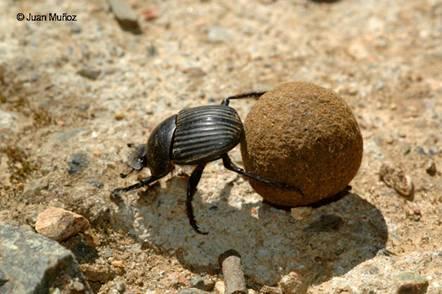Taxonomic classification [1.]
• Regnum: Fossil
• Phylum: Arthropods (ARTHROPODA)
• Class: Insecta
• Ordo: Coleoptera
• Subordo: Polyphaga
• Superfamilia: Scarabaeidae
• Family: Geotrupinae
• Genus Geotrupes
• Species: Geotrupes stercorarius
Distribution
The larger dung beetle (Geotrupes stercorarius) spread throughout Europe, eastern Siberia to occur. Typically located in the temperate zone [1].
Morphology, structure
The dung beetles are at slightly higher than the ground beetles, for which comparable only to the extent that the mouth shield not be obscured. Chewing mouth parts [2.]. Abdomen of six rings are formed, their eyes on the spur of spans jaws, antennae and front legs eleven-jointed outer edges of disarmed wide teeth. Six legs, of which the first pair of knurled gereblyeszerűen, which is out of the manure and elásására serve. Clumsy, hard and strong body, páncélszerű, shiny metallic steel blue or greenish. A pair of membranous wings, the kitines fedőszárny below. All rakely 14 wingshield furrow is clearly visible. Length of an individual is usually between 16-27 mm [1.].
Nutrition
Gana main diet is higher mammals, respectively. rotting organic matter. Front and rear legs move backwards with their feet pushed the ball [1.].
Habitat
Dung beetles hide in the day, or only with difficulty and slowly move the earth. At dusk, especially in hot and windless nights will revive, roaring flight call attention to themselves, eating and looking for appropriate locations to put the eggs [1.].
Many can chirp, so that the third abdominal sections lécszerűen sharp pop-up rear edge of rear grooved rub to its haunch’s chirpspacer. Verhoeff observed that effect can be confirmed that the back plate of the abdomen more mountainous and covered with stiff hairs objects rubbed the back of the wing underside, making them vibrate and come roaring noises [1.].
Reproduction
The mating season is summer, the one-year maturity at the age of the specimens reached [3.]. The most commonly provide a brood pair. The manure for their nourishment, and their positive spawner. Almost vertical flight of the turd dig directly under or near a depth of 60-100 cm. It mainly a number of short collaterals ending blindly and open, which is necessary for rearing juvenile quantity of turd wear. The eggs (3−6 pcs) hollow "galacsinok" placed inside. Three to four weeks after a small rise from the egg is Pajor, which is stored in the cold season lasts turd feeds. The hibernation after their own excrement make the corridor walls, crib so hard up for himself, which in June or July converted into puppets. The cocoon calmness three-four weeks after the first half of August is a hatch in the cocoon of the beetle [1.].
Not only fresh manure or plant parts are stored in the offspring of dung beetles, but for example. Large dung of pine needles, pieces of wood, or even blitz him paper [2.].
Role in the ecosystem
This species consumes a lot of fox and carnevorous welcome. High around 18 months of living in dung [1.]. Dung beetles dug out the threads carry the dung and there it is consumed. In this useful work, because in addition to large quantities of material indicated on the surface of the soil also contribute to improving the quality. Ohaus observed that stubble lying on a large, almost 1 / 4 m in circumference, horse dung, with little remaining except one disappeared from the earth during the night back. The results concluded that 92 pieces of this work was carried out by large dung beetle [1.]. By man is not an endangered species.
[1.] http://mek.niif.hu/03400/03408/html/2803.html
[2.] http://hu.metapedia.org/wiki/Ganajt%C3%BAr%C3%B3_bogarak
[3.] http://www.haziallat.hu/terrarium/izeltlabu-fajok/a-szkarabeusz-bogar/3071/
